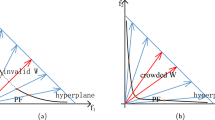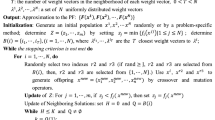Abstract
Multiobjective evolutionary algorithm based on decomposition (MOEA/D) works by using a set of uniformly distributed weight vectors to decompose a multiobjective optimization problem (MOP) into multiple single objective optimization subproblems for simultaneous optimization. Selecting parents from the neighborhood when performing reproduction is highly probable, thus different operators and neighborhoods may produce different offspring. However, one omnipotent operator usually cannot handle all different complex MOPs very well, for this reason, we propose a weight grouping operators selection (WGOS) strategy. Firstly, we divide the weight vectors into several groups and assign different reproduction operators to each group. The subproblems in each group are optimized by using the reproduction operators assigned. Then, the size of each group is dynamically adjusted according to the quality of the generated offspring, and the group of the reproduction operator that generates the better offspring expands, and the group of the reproduction operator that generates the worse offspring shrinks correspondingly until all the groups are merged into one and all adopt the same reproduction operator. This process will eventually pick out one operator for subsequent evolution. Finally, we will verify the performance of the selected operator to decide whether to continue using it or switch to another operator. A large number of comparative experiments have proved this strategy has better performance.











Similar content being viewed by others
Data Availability Statements
Data supporting the results of this study are available from the corresponding author upon reasonable request, including source code and experimental results.
References
Chen Q, Sun J, Palade V, Wu X, Shi X (2021) An improved gaussian distribution based quantum-behaved particle swarm optimization algorithm for engineering shape design problems. Eng Optim, 1–27
Farag A, Al-Baiyat S, Cheng T C (1995) Economic load dispatch multiobjective optimization procedures using linear programming techniques. IEEE Trans Power Syst 10(2):731–738
Pisacane O, Potena D, Antomarioni S, Bevilacqua M, Diamantini C (2020) Data-driven predictive maintenance policy based on multi-objective optimization approaches for the component repairing problem. Eng Optim, 6
Sang H Y, Duan P Y, Li J Q (2017) An effective invasive weed optimization algorithm for scheduling semiconductor final testing problem. Swarm Evol Comput 38:42–53
Li J Q, Song M X, Wang L, Duan P Y, Han Y Y, Sang H Y, Pan Q K (2020) Hybrid artificial bee colony algorithm for a parallel batching distributed flow-shop problem with deteriorating jobs. IEEE Trans Cybern 50(6):2425–2439
Ruela A S, Delgado K V, Bernardes J (2020) A multi-objective evolutionary approach for the nonlinear scale-free level problem. Appl Intell 50(11)
Xu J, Zhang Z, Hu Z, Du L, Cai X (2020) A many-objective optimized task allocation scheduling model in cloud computing. Appl Intell 51(1):1573–7497
Chen J, Xu Y, Sun W, Huang L (2021) Joint sparse neural network compression via multi-application multi-objective optimization. Appl Intell 51(6):7837–7854
Miettinen K, Mkel M M, Mnnikk T (1998) Nonlinear mult/objective optimization. Comput Optim Applic 11(2):177–194
Deb K, Pratap A, Agarwal S, Meyarivan T (2002) A fast and elitist multiobjective genetic algorithm: NSGA-II. IEEE Trans Evol Comput 6(2):182–197
Zitzler E, Künzli S (2004) Indicator-based selection in multiobjective search. In: International conference on parallel problem solving from nature. Springer, pp 832–842
Zhang Q, Hui L (2008) MOEA/D: a multiobjective evolutionary algorithm based on decomposition. IEEE Trans Evol Comput 11(6):712–731
Qi Y, Ma X, Fang L, Jiao L, Sun J, Wu J (2014) MOEA/D with adaptive weight adjustment. Evol Comput 22(2):231–264
Dai C, Lei X (2018) A decomposition-based multiobjective evolutionary algorithm with adaptive weight adjustment. Complexity 2018:1–20
Meghwani S S, Thakur M (2021) Adaptively weighted decomposition based multi-objective evolutionary algorithm. Appl Intell 51(4):1–23
Li E, Chen R (2020) Multi-objective decomposition optimization algorithm based on adaptive weight vector and matching strategy. Appl Intell, 6
Ma X, Yu Y, Li X, Qi Y, Zhu Z (2020) A survey of weight vector adjustment methods for decomposition based multi-objective evolutionary algorithms. IEEE Trans Evol Comput PP(99):1–1
Deb K (2001) Multi-objective optimization using evolutionary algorithms, p 16. Wiley
Storn R, Price K (1997) Differential evolution – a simple and efficient heuristic for global optimization over continuous spaces. J Glob Optim 11(4):341–359
Li K, Fialho A, Kwong S, Zhang Q (2014) Adaptive operator selection with bandits for a multiobjective evolutionary algorithm based on decomposition. IEEE Trans Evol Comput 18(1):114–130
Zhang S X, Zheng L M, Liu L, Zheng S Y, Pan Y M (2016) Decomposition-based multi-objective evolutionary algorithm with mating neighborhood sizes and reproduction operators adaptation. Soft Comput 21(21):6381–6392
Yan Z, Tan Y, Zheng W, Meng L, Zhang H (2021) Leader recommend operators selection strategy for a multiobjective evolutionary algorithm based on decomposition. Inf Sci 550:166–188
Lin W, Lin Q, Ji J, Zhu Z, Wong K C (2021) Decomposition-based multiobjective optimization with bicriteria assisted adaptive operator selection. Swarm Evol Comput 60:100790
Li H, Zhang Q, Deng J (2016) Biased multiobjective optimization and decomposition algorithm. IEEE Trans Cybern 47(1):52–66
H X, Xue B, Zhang M (2020) A duplication analysis based evolutionary algorithm for bi-objective feature selection. IEEE Trans Evol Comput PP(99):1–1
Cheng R, Jin Y, Narukawa K, Sendhoff B (2015) A multiobjective evolutionary algorithm using gaussian process-based inverse modeling. IEEE Trans Evol Comput 19(6):838–856
Zille H (2019) Large-scale multi-objective optimisation: new approaches and a classification of the state-of-the-art
Tian Y, Zheng X, Zhang X, Jin Y (2019) Efficient large-scale multi-objective optimization based on a competitive swarm optimizer. IEEE Transactions on Cybernetics, 1–13
Yan, Qiao, Coello, Carlos, A., Coello, Liang, Zhengping, Liu, Zhiwang (2016) Adaptive composite operator selection and parameter control for multiobjective evolutionary algorithm. Inform Sci: Int J 339:332–352
Zhang Q, Zhou A, Zhao S, Suganthan P N, Tiwari S (2008) Multiobjective optimization test instances for the cec 2009 special session and competition. Mechanical engineering (New York, N.Y.: 1919)
Zitzler E, Deb K, Thiele L (2000) Comparison of multiobjective evolutionary algorithms: Empirical results. Evol Comput 8(2):173–195
Huband S, Hingston P, Barone L, While L (2006) A review of multiobjective test problems and a scalable test problem toolkit. IEEE Trans Evol Comput 10(5):477–506
Deb K, Thiele L, Laumanns M, Zitzler E (2006) Scalable test problems for evolutionary multi-objective optimization. Evolutionary Multiobjective Optimization
Ye T, Ran C, Zhang X, Jin Y (2017) Platemo: a matlab platform for evolutionary multi-objective optimization. IEEE Comput Intell Mag 12(4):73–87
Zitzler E, Thiele L, Laumanns M, Fonseca C M, Fonseca V (2003) Performance assessment of multiobjective optimizers: an analysis and review. IEEE Trans Evol Comput 7(2):117–132
Zitzler E, Thiele L (1999) Multiobjective evolutionary algorithms: a comparative case study and the strength pareto approach. IEEE Trans Evol Comput 3(4):257–271
Acknowledgements
The work is partially supported by the National Natural Science Foundation of China (Nos. U1836216, 61772322), the major fundamental research project of Shandong, China(Nos. ZR2020MF042, ZR2019ZD03).
Author information
Authors and Affiliations
Corresponding author
Additional information
Publisher’s note
Springer Nature remains neutral with regard to jurisdictional claims in published maps and institutional affiliations.
Rights and permissions
About this article
Cite this article
Shi, L., Tan, Y., Yan, Z. et al. Weight grouping operators selection strategy for a multiobjective evolutionary algorithm based on decomposition. Appl Intell 53, 10585–10601 (2023). https://doi.org/10.1007/s10489-022-03900-x
Accepted:
Published:
Issue Date:
DOI: https://doi.org/10.1007/s10489-022-03900-x




